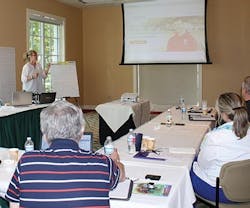Functional Programming is Your Key to Success
Often personal experience drives perceptions. Early in my career, I worked in-house at a senior living development and operations company. I was hired to complete contract administration, coming in after design was completed, during construction. This process resulted in observing the manifestation of a continuous gap between the built environment’s needs and the design’s solution.
Based on this realization, I started to attend operational meetings to better understand how everything functions—resulting in a design process that would support the desired outcomes for both residents and staff. This was the basis for my consulting practice—improving outcomes through the built environment based on resident, staff, and operational needs.
The process is now defined as the functional programming process in the Facility Guidelines Institute’s (FGI) guidelines for hospitals, outpatient, and residential long-term care settings (for more info, visit www.fgiguidelines.org). The following sections define the steps and the importance of completing a functional program that results in a successful project.
establishing a care model
The functional program process begins by gathering all of the disciplines together, including management and administration, to discuss the goals of the project. For a large scale re-positioning or new project, the first workshop usually includes discussion on organizational options for care models and the desired outcomes of a project.
It is important as design professionals to understand an organization’s mission and core values, as the framework is utilized to evaluate options in existing as well as new potential care models. The workshop covers impacts on current staff ratios, opportunities for positive change based on industry trends and reimbursements, educational and training needs, and financial and marketing influences. For our clients, this is the time in the planning and programming process where we discuss resident-centered care and whether alternate care models should be reviewed. This step is very important, so that the functional program can reflect the project needs, informing the physical space program and concept design.
sustainability goals
Identifying the sustainable goals for the project are not only about greening the building, but also evaluating the entire sustainable business model. The continuous improvement of the desired resident/patient outcomes, and the operational functions, relies on periodic evaluation as well as ongoing commissioning of the physical environment. All three of these dimensions are evaluated through the filter, and reflective of an organization’s mission and core values. It’s a quality improvement process, which includes the ROI evaluation and ongoing review.
Part of establishing the goals often includes the selection of a building rating system such as LEED, Green Globes, and the all-inclusive Senior Living Sustainability Guide, which includes information for evaluating resident/patient desires and needs, organizational mission, and operational goals supported by the designed environment. However, it is important to note that reviewing the building is only a piece of the ongoing continual improvement process necessary for maintaining person-centered care. Utilizing a tool such as Green Globes for Existing Buildings for Healthcare strives to engage not only the building performance, but also the patient/resident and staff outcomes, and operational functions for continual improvement. The process uses an electronic survey tool, and if desired by a client, it can include third-party certification. A trained assessor comes onsite to review the documentation and physical plant, and meet with different departments, staff, and patients/residents. The process results in individualized recommendations for continual improvement, and a checklist is available on the Green Building Initiative website.
resilience based on region
With the occurrence of both natural and manmade disasters, resilience has been a very popular topic among not only design professionals, but also regulators, government agencies, and liability insurance carriers. Healthcare settings already include emergency preparedness planning and procedure development. However, when renovating or building new, understanding potential climate change impacts on a site is important to consider from the beginning, in conjunction with anticipated building service life considerations.
GSA recently held a workshop titled, “Strategically Incorporating Sustainability, Resilience, and Footprint Consolidation in Portfolio Planning” that includes discussion on space utilization, which is well reflected in the functional programming process outlined in the Facility Guidelines Institute’s hospital, outpatient, and residential care guidelines. The Veterans Administration presented during the conference to highlight the need for incorporation of resilience in healthcare facilities and reaffirm the need for regular periodic assessments for successful continual improvement to occur.
operational needs, circulation, and service delivery
Once the workshop takes place, I recommend holding focus groups with the different disciplines, residents, patients, and families to better understand the needs of each area. This includes details on how each and every function will be completed throughout a proposed space.
For example, evaluate the delivery of services, storage of supplies at point of use, shift requirements, medication delivery, dining service approaches, location of vertical and horizontal circulation, and other processes required to deliver a resident-centered, decentralized care model.
Another example is examining the process of arriving to a community or facility, and identifying the wayfinding needs, reception requirements, admissions involvement, delivery and materials management flows, and other processes specific to the entry experience. If a design professional understands the functions and flows throughout a facility, the building will better support efficiency, enjoyment, and utilization of space.
safety risk assessment
This assessment is part of the functional programming process. It is outlined in both of the 2014 FGI Guideline books. Additionally, the Center for Health Design has developed a toolkit to assist providers and designers with the evaluation process for hospitals and outpatient facilities.
There is additional guidance for long-term care settings available in the FGI’s “Guidelines for Design and Construction of Residential Health, Care, and Support Facilities.” The assessment components consider risks surrounding infection control, mobility and transfer, fall and prevention, dementia and mental health, medication error, security, disaster, and emergency preparedness.
desired outcomes
Consider the goals of the space, and identify the patient experience. If you have a stressed visitor that is arriving because something happened to a loved one, the desired outcome is to be supportive and provide the guest with as much information as soon as possible. Therefore, excellent wayfinding and guidance from staff member are musts. The design needs to provide spaces and amenities that create an understanding environment.
For example, the concierge may send visitors to a garden where the clinical professional will meet to discuss what has happened and next steps, then escort them to the patient’s room. The room may include accommodations that allow the guest to stay overnight. Different design alternatives can support not only the needs and functions, but also the human factor.
environment of care
There are key elements to be considered when designing an environment of care, and they have direct impact on the users. They include lighting (daylight and artificial), views of and access to nature, signage and wayfinding, user control of the environment, privacy and confidentiality, safety and security, characteristics and criteria for architectural detailing, surfaces and furnishings, cultural responsiveness, and support for person-centered care.
This step is important in the development of the overall program, because it connects the outcomes of workshops and focus groups to actual physical ramifications.
benchmarking and performance improvement goals
Setting up a continual improvement process includes evaluating areas that have data available. Benchmarking can help reach performance improvement goals. At the onset of the project, research is utilized to inform an evidence-based design approach, but data can be collected and evaluated for improvements.
For example, if fall risk is a main concern in a senior living setting, reviewing research provides background for design decisions that could mitigate the risk. Providers can then link the positive outcome to ROI, and meet the performance goals outlined in the programming and planning process.
programmed for success
As a designer that has completed functional programming for various sized projects over several years, I can attest to the successful outcomes that have been obtained by many care providers, residents, and their families. The size and scope of a project will determine the detail and appropriateness of each step outlined above.
For projects that have created an overall framework prior to starting design, the process has become the go-to method for evaluating decisions, identifying gaps, and providing parameters for mock-ups. It even often delineates training and education needs for staff members that utilize a different care model.
Return on investment for utilizing the planning and programming process is demonstrated through reduction in contract administration time, fewer change orders over the life of a project, more cohesive care management and delivery, and overall improved outcomes for users. I encourage interior designers to include this approach in their service offering. Your clients will be thrilled with the results!
Jane Rohde is the founding principal of JSR Associates, Inc., in Ellicott City, Md. She champions a global cultural shift toward deinstitutionalizing senior living and healthcare facilities through person-centered principles, research and advocacy, and design of the built environment. Clientele includes nonprofit and for-profit developers, government agencies, senior living and healthcare providers, and design firms. She speaks internationally on senior living, aging, healthcare, evidence-based design, and sustainability. She is the first recipient of the Environments for Aging Changemaker Award presented by the Center for Health Design. For questions or comments, reach her at [email protected].
About the Author

Jane Rohde
AIA, FIIDA, ASID, ACHA, CHID, LEED AP BD+C, GGA-EB
Jane Rohde, AIA, FIIDA, ASID, ACHA, CHID LEED AP BD+C & GGA – EB: Jane Rohde is the founding principal of JSR Associates Inc. in Catonsville, MD. JSR Associates Inc. celebrates 23 years of consulting services in 2019. Jane is the recipient of the 2015 Environments for Aging Changemaker Award and in 2018 she received the ASID Design for Humanity Award, was recognized as an Honorary Alumni of Clemson University’s Architecture + Health program, and has been honored as one of 10 notable Women in Design. For more information or comments, please contact Jane Rohde at [email protected] or “Chat with Jane” at www.jsrassociates.net.
